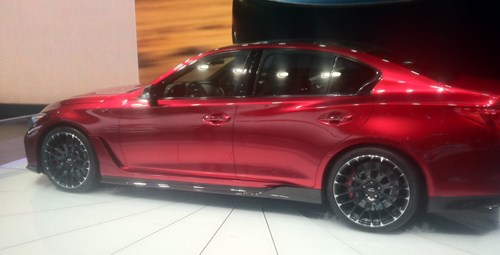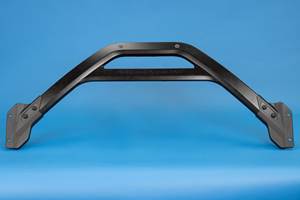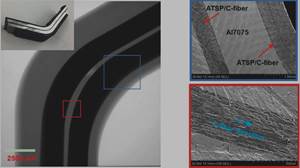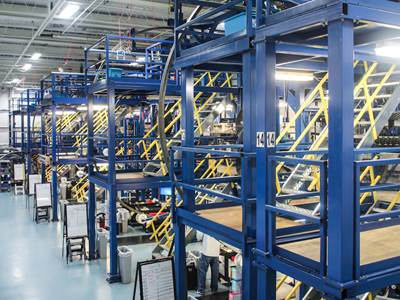At NAIAS, composites not difficult to find
With CAFE requirements steadily increasing each year, en route to 54.5 mpg by 2025, automakers of all stripes are working composites into new and concept cars.

The Infiniti Q50, at NAIAS in Detroit, features sheet molded compound (SMC)
body panels and interior carbon fiber accents.
The 25th anniversary of the North American International Auto Show (NAIAS) took place at Detroit, Mich.’s Cobo Center in January, giving visitors a chance to view dozens of new production vehicles, models and concept cars, as well as providing them with an up-close look at the rapidly changing face of the industry.
In the 25 years since morphing from the Detroit Auto Show into NAIAS, manufacturers have introduced more than 1,300 new vehicles here, with 81 percent of them being first-time, worldwide unveilings.
As in previous shows, technology is the main driver of change, although the pace of innovation in recent years has accelerated, with robust competition for markets and unprecedented technical challenges — one of the key ones being increasing fuel economy standards that will require manufacturers to achieve a fleet average of 35.5 mpg by 2016 and 54.5 mpg by 2025.
Composites, as well as other materials, are expected to play an integral role in the design and manufacture of this next generation of vehicles, a case in point being the BMW i3, the company’s first fully electric vehicle, which made its North American debut at the show. The vehicle comprises a 22-kWh lithium-ion battery and passenger "life module" and other parts constructed of lightweight carbon fiber composites supplied by SGL Automotive Carbon Fibers (Moses Lake, Wash.), a joint venture established by BMW Group and SGL Group. SGL ACF produces carbon fibers from a polyacrylonitrile (PAN)-based thermoplastic textile fiber precursor. The plant at Moses Lake runs two production lines capable of producing a total of 3,000 tonnes of fiber per year. The rovings are shipped to another SGL ACF facility in Wackersdorf Innovation Park, Germany where they are processed into carbon fiber fabrics. The fabrics are stacked, cut into preforms and processed into parts via a high-pressure resin transfer molding (RTM) process.
The 4-door BMW i3 is 157 inches/399 cm long, 62 inches/157 cm tall and its electric motor delivers 170 hp and reported acceleration from 0-60 mph of 7 seconds. When fully charged the car has a driving range of 80 to 100 miles. Sources at the show say the first deliveries of the car to U.S. customers are expected in May, and report the company has 11,000 confirmed orders on the books for 2014. BMW is planning on starting production of its first plug-in hybrid 2 + 2 sports car, the BMW i8, in second quarter 2014. The car will also feature a passenger life module and other parts made from carbon fiber.

Corvette Z06
Winner of the 2014 NAIAS Car of the Year Award, the Chevrolet 2015 Corvette Z06, has been repackaged with a supercharged 6.2L V8 engine that delivers more than 625 hp. As with all 7th generation Corvette models, the Z06 comes with a standard carbon fiber hood; additionally the coupe version features removable carbon fiber roof panels. Seventh generation models are also manufactured with a substructure made from a carbon nano-composite. The pieces of the substructure connect the body panels to the chassis; the carbon nano-filled composite components provide about 9 lb/4 kg of weight savings compared to earlier sheet molding compound (SMC) molded versions of the substructure.
New to the Z06 is a carbon fiber torque tube, which connects the engine to the rear-mounted transaxle. The Z06 also comes with an optional carbon fiber aerodynamic package, which includes a carbon front splitter with winglets, carbon fiber rocker panels and larger rear spoiler. The Z06 package includes carbon-ceramic brake rotors.

SRT Viper
In 2012, Chrysler Group’s SRT (Street and Racing Technology) brand began manufacturing a completely redesigned version of the SRT Viper. All standard SRT models come equipped with a hood, roof and liftgate molded from carbon fiber prepreg by Plasan Carbon Composites (Bennington, Vt.). Additionally, the windshield frame comprises a glass/carbon fiber SMC, facilitating, in total, a 32 percent weight savings compared to the previous, all-metal model.
At this year’s show, SRT launched a new limited-run Viper GTS Anodized Carbon Special Edition. The Special Edition’s new metallic matte exterior color provides even greater accentuation to the vehicle’s shape, according to SRT officials. “The Viper’s unique, hand-built and hand-painted process allow us to create these ultra-exclusive special series builds,” said Ralph Gilles, president and CEO, SRT Brand and Motorsports, Chrysler Group LLC. The car’s interior is also equipped with carbon fiber accents throughout the center stack, door panels, steering wheel and dashboard. The company plans to build about 50 of the Anodized Carbon Special Edition Vipers in 2014. SRT also revealed a new “Stryker Green” color for the Viper at the show.
Nissan displayed a number concept sports cars intended to capitalize on innovative trends in product design and development, and reach younger customers. The company’s Sport Sedan Concept car, a world debut, highlighted what the company termed, “a number of unique design signatures,” including V-motion front aspect and a “floating” roof design, which engineers plan to adapt on future Nissan sedans and crossovers. The car also included a number of carbon fiber accent components in the front fender and headlamp, as well as carbon fiber rocker panels and ground effects.
Nissan’s luxury brand, Infiniti, introduced the Q50 Eau Rouge concept. The car, a heavily modified version of its production Q50, is envisioned as the company’s entry into the performance car market segment. While labeled as a concept, the car is one that Infiniti president Johan de Nysschen “absolutely insists,” will be put into production, perhaps as early as the 2016 model year. The vehicle at the show was equipped with a V-6 engine, but de Nysschen said he expects the production vehicle will be built with either a V-8 or turbocharged V-6 capable of generating more than 500 hp, which would put it on par with performance models produced by BMW, Audi and Mercedes Benz. The display car was built with SMC body panels, carbon fiber exterior ground effects and carbon fiber interior detailing.
Released in 2012, Tesla’s Model S is now being offered with a carbon fiber spoiler in a new matte finish, as well as in the original glossy finish.
In other materials-related news, Ford Motor scored what some journalists are calling the biggest car reveal at the 2014 NAIAS when it announced it is converting the body of the 2015 F-150 pickup from steel to aluminum. The conversion to an all-aluminum body sheds about 700 lb/318 kg compared to previous generation F-150s, with a resulting boost in fuel economy. Ford reportedly secretly field-tested the aluminum truck by lending it to construction crews and other heavy-duty operators without revealing what they were testing. Some industry observers believe the redesign gives the F-150 the performance edge over the competition because it provides more load and trailer-carrying capacity, while others see a risk in both the price premium for aluminum, and the possibility of alienating longtime buyers of the F-150 with the switch away from steel.
While metal is still the predominant structural material of choice, a stroll through this year’s NAIAS revealed more advanced composites on more production or near-production vehicles than any time in the event’s history.
Related Content
Automotive chassis components lighten up with composites
Composite and hybrid components reduce mass, increase functionality on electric and conventional passenger vehicles.
Read MoreNovel dry tape for liquid molded composites
MTorres seeks to enable next-gen aircraft and open new markets for composites with low-cost, high-permeability tapes and versatile, high-speed production lines.
Read MoreNew polymer expands composites options in demanding environments
Aromatic thermosetting copolyester offers unique properties, availability in multiple form factors.
Read MoreASCEND program update: Designing next-gen, high-rate auto and aerospace composites
GKN Aerospace, McLaren Automotive and U.K.-based partners share goals and progress aiming at high-rate, Industry 4.0-enabled, sustainable materials and processes.
Read MoreRead Next
Modeling and characterization of crushable composite structures
How the predictive tool “CZone” is applied to simulate the axial crushing response of composites, providing valuable insights into their use for motorsport applications.
Read MorePlant tour: A&P, Cincinnati, OH
A&P has made a name for itself as a braider, but the depth and breadth of its technical aptitude comes into sharp focus with a peek behind usually closed doors.
Read MoreCFRP planing head: 50% less mass, 1.5 times faster rotation
Novel, modular design minimizes weight for high-precision cutting tools with faster production speeds.
Read More




















